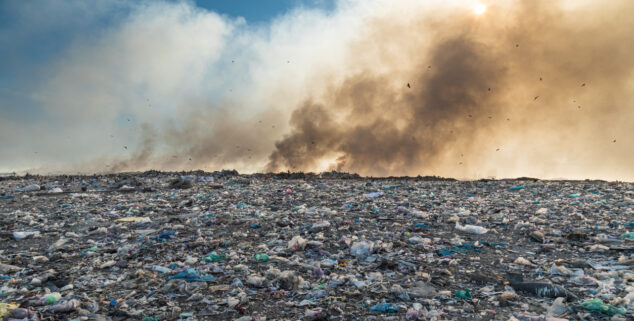Opinion
California must act now to stop methane leaks from landfills
 Landfill with burning trash piles. Image by Collab Media
Landfill with burning trash piles. Image by Collab MediaOPINION – California has long been a leader in the fight against climate change, but in the crucial battle to reduce methane emissions from landfills, we are falling behind. It’s time for the California Air Resources Board to address this problem before it’s too late.
Methane is an immensely potent greenhouse gas, more than 80 times more powerful than carbon dioxide over a 20-year period. In California, landfills are among the top sources of methane emissions, and the situation is more urgent than many realize. A recent study found over 100 large methane plumes from California landfills in 2023, presenting dangers to both environmental and public health.
Landfills not only release methane; they also emit hydrogen sulfide, benzene, and other volatile organic compounds that can cause headaches, exacerbate asthma, and even lead to cancer. Communities living in the shadow of these landfills may be breathing this dangerous air, which raises the question: is California doing enough to protect them? .
The science is clear: Reducing methane emissions is the most impactful climate action we can take right now. And while California led the way in 2010 with regulations on landfill methane that were stricter than federal standards, those rules have not kept pace with technological advancements. In the past 14 years, new technologies and operational practices have been developed that can drastically cut methane emissions from landfills. Yet California’s regulations remain stagnant, and other states like Washington and Oregon have leaped ahead with more stringent standards.
CARB’s own research shows that some landfills are doing far better than others at controlling emissions, largely due to their adoption of newer technologies and better practices. If these effective methods were mandated across all landfills, California could see a substantial reduction in methane emissions. The current patchwork approach allows many operators to continue with outdated and less effective methods, undermining the state’s broader climate goals.
The solution is clear: the Air Resources Board must immediately overhaul its Landfill Methane Rule (LMR) to reflect the best available science and technology. At a minimum, these new rules should require all regulated landfills to use the most effective methane monitoring technologies, including remote sensing, drone surveillance, and continuous monitors. These technologies can more efficiently and accurately identify methane emissions, allowing for quicker and more effective interventions. Simply put, if you can’t find the leaks, you can’t fix them.
How would this work in practice? To find leaks, landfills would be required to expand their monitoring of emissions to cover the entire surface of the landfill, including areas like steep slopes and active sections that are currently left out of the regulations. Using drones to search for methane leaks, as Canada has proposed, would ensure thorough monitoring everywhere. To prevent leaks, CARB should also require shorter downtimes for systems that collect methane gas and speed up the installation of gas capture systems.
CARB has already laid the groundwork for these changes in its 2022 Scoping Plan for Achieving Carbon Neutrality, which includes goals for reducing landfill methane emissions as part of broader efforts to cut greenhouse gases.
But the agency has dragged its feet when it comes to turning these goals into reality. Two years ago, I introduced AB 1534, which would have pushed CARB to consider requiring landfills to use remote sensors like drones to identify methane leaks. In the agency’s view, my bill was unnecessary, but timely efforts to update their Landfill Methane Rule have been lacking while methane emissions go unchecked.
CARB did hold a workshop in December to consider the agency’s next steps, but did not commit to any changes in the regulations and decided on a timeline that would delay implementation of any improvements until at least 2027. That’s not good enough.
Methane’s devastating impact on our climate is immediate and undeniable. It’s time for CARB to step up and ensure that all landfills in the state are held to the highest standards. CARB must lead the charge to reduce methane emissions—our climate, our communities, and our future depend on it.
Assemblymember Jacqui Irwin serves California’s 42nd Assembly District encompassing much of Ventura County and portions of Los Angeles County. A former engineer, Assemblymember Irwin has authored a number of bills that focus on the environment and sustainability during her 10 years in the Legislature.
Want to see more stories like this? Sign up for The Roundup, the free daily newsletter about California politics from the editors of Capitol Weekly. Stay up to date on the news you need to know.
Sign up below, then look for a confirmation email in your inbox.

Leave a Reply